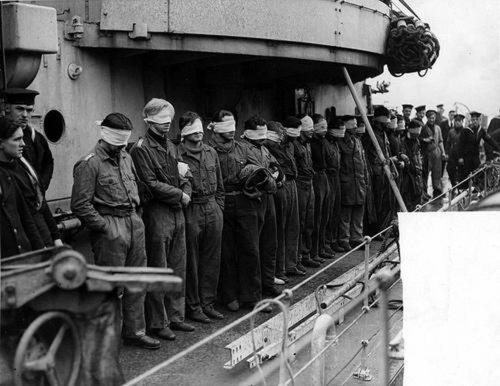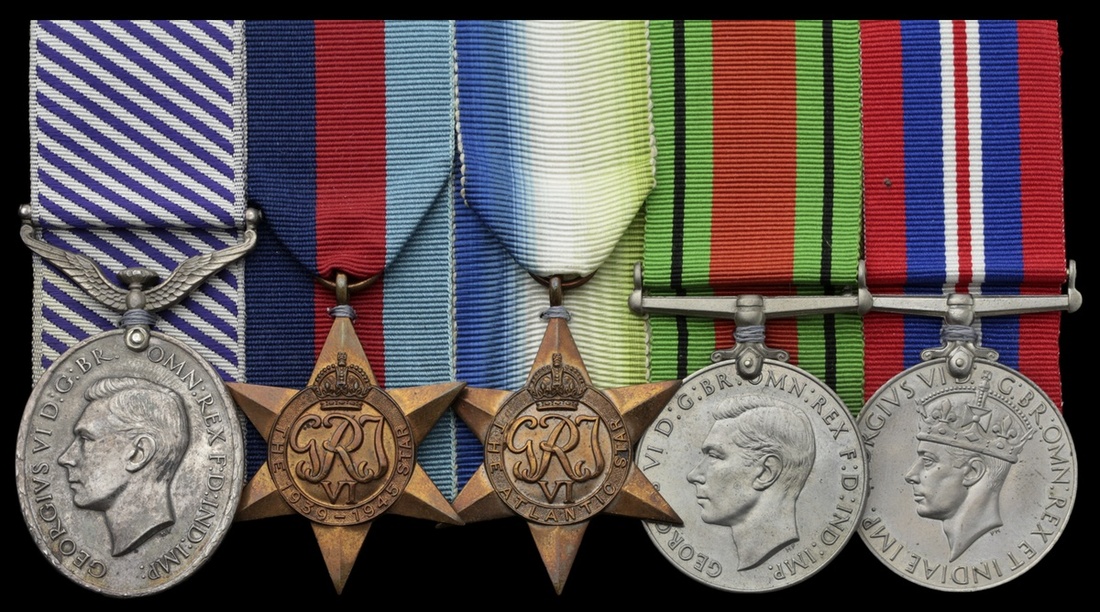Auction: 22003 - Orders, Decorations and Medals
Lot: 486
'Kapitänleutnant Hans Speidel is the perfect Nazi or, in the words of the Welfare Officer who met him, "a complete swine." He boasts that he wears the Golden Hitler Youth Badge, and his behaviour is insolent and arrogant. He speaks good English, having spent two years in England as a student. His chief concern in his U-Boat seems to have been security, which he drilled into his men ad nauseam. Unfortunately, he had further opportunity of doing so during the transfer of the prisoners after disembarkation in the United Kingdom. It was said that he slept 24 hours a day while on patrol. He was hated and feared by all on board … '
So states an Admiralty Naval Intelligence Department report, dated December 1943, following the capture of Speidel and 17 of his crew from the U-643.
A fine Second World War Coastal Command D.F.M. group of five awarded to Flight Sergeant J. G. Jeans, Royal Air Force Volunteer Reserve, who participated in the destruction of the U-643 in October 1943, when he filmed 'an unusually fine pictorial record of the action which proved of considerable propaganda value'
Having somehow survived two previous attempts to close her surfaced prey - attempts marked by heavy flak - Jean's Liberator of No. 120 Squadron dropped to just 30 feet on a 'third time lucky' run and delivered a deadly pattern of depth charges:
'The U-Boat was seen to explode forward of the bridge structure and to sink immediately by the bows. The grey explosion plume rose to a height of 150 feet and survivors were seen being thrown into the water with many being killed. A large oil patch, 300 yards across, was then visible with scattered wreckage …'
Distinguished Flying Medal, G.VI.R. (985715 F./Sgt. J. G. Jeans, R.A.F.); 1939-45 Star; Atlantic Star; Defence and War Medals 1939-45, good very fine (5)
D.F.M. London Gazette 18 January 1944. The original recommendation states:
'This N.C.O. has served with No. 120 Squadron on anti-submarine warfare in the North Atlantic for 18 months. At all times he has displayed a high technical ability and by his cheerful disposition and keenness in the execution of his duties he has set a high example for other Flight Engineers.
On 8 October 1943, he was a member of a crew of an aircraft which attacked and sank an enemy submarine. By the skilful operation of a camera, he obtained an unusually fine pictorial record of the action which proved of considerable propaganda value.
The very valuable and devoted service of this N.C.O. on anti-submarine operations is fully deserving of the award of the Distinguished Flying Medal.'
James Gill Jeans qualified as a Flight Engineer after enlisting in the Royal Air Force Volunteer Reserve and joined No. 120 Squadron of Coastal Command in the summer of 1942.
No. 120 Squadron: The Sub-smashers
Equipped with Liberators, No. 120 undertook countless anti-submarine patrols and became the highest-scoring squadron of the war, particularly whilst operating out of Reykjavík. It claimed 14 confirmed outright 'kills', three shared and eight more U-Boats as damaged. As such, the Squadron's activities hit the home press, eliciting such headlines as 'Sub smashers win 5 awards in big convoy fight'.
Commanded by Kapitänleutnant Hans Speidel, U-643 was sunk on the afternoon of 8 October 1943, by Liberator 'T' of No. 120 Squadron, piloted by Flying Officer D. C. L. Webber, with Jeans as Flight Engineer. Eighteen prisoners, including Spiedel, the Engineer Officer and the Medical Officer survived, being picked up by H.M. ships Oribi and Orwell. The total complement of the U-Boat was 48.
Fortunately for posterity's sake, Jeans captured spectacular camera footage of the action. Better still, a detailed Naval Intelligence Department (N.I.D.) report survives, from which the following extracts have been taken:
'Anniversary Celebration
U-643 began the day of 8 October, 1943, confidently and with high hopes. It was her anniversary and at 0800 Kapitänleutnant Speidel ordered one minute for silent reflection on the U-Boat's commissioning a year ago and for renewing high resolve. He then announced that they would mark the occasion by performing some deed worthy of the day.'
'First attack
Accordingly, when U-643 obtained a G.S.R. contact on an aircraft shortly after 1300, the Captain did not dive, but ordered the guns to be manned. There was plenty of time, and all was in readiness when the aircraft approached. Fire was opened immediately and prevented the aircraft from making an accurate attack so that her depth-charges did no damage.
(N.I.D. Note: At about 1313 on 8 October, 1943, Liberator Z-86 sighted a U-Boat, Green 30°, distant seven miles, and attacked from 020° Red quarter with two Mark XI depth-charges. Evasive action by the U-Boat prevented the use of the bombsight and the depth-charges entered the water 60 ft. ahead of the bows. Flak from the U-Boat was ineffective).'
'Second attack
Suddenly there appeared directly astern of the first aircraft a second Liberator running in at high speed to attack. The U-Boat's gunners shifted their sights to this new target and gave it all they had. As a result, the aircraft's depth-charges fell wide of their mark and inflicted no damage.
(N.I.D. Note: At 1312 on 8 October, 1943, Liberator T-120, on passage to escort S.C. 143, flying on track 166 at 1,800 ft. obtained an S/E contact and made visual sighting simultaneously on a U-Boat on the surface bearing Red 15°, distant eight miles, in position 56° 18' N., 26° 30' W. Course 80°, speed 12 knots. The U-Boat was of the 500-ton type and only four men were noticed on the bridge. The aircraft climbed into cloud and made a direct approach from approximately four miles, experiencing heavy flak from the U-Boat which made the continuation of direct approach unhealthy. The aircraft took violent evasive action and attempted to make a head-on attack, but because of the evasive tactics of the U-Boat, the attack was finally delivered from Green 100°. Four Mark XI Torpex depth-charges, set to shallow depth, spaced 60 ft., were released from 100 ft. while the U-Boat was on the surface. The depth-charges were seen to overshoot, No. 1 exploding 200 feet ahead of the U-Boat in line with her course. The U-Boat appeared to be undamaged and the aircraft's pilot prepared for a second attack).
'Third attack
Liberator T-120 attacked a second time from Green 100°, releasing from 30 ft. four Mark XI Torpex depth-charges, same setting as before, upon the still surfaced U-Boat. The charges were seen to straddle the U-Boat, No. 1 falling to starboard and Nos. 2, 3 and 4 to port. No. 1 depth-charge exploded below the U-Boat and the remainder exploded on the port side.
The U-Boat then slowed down and the aircraft made a front gun attack from the bows. No opposition was encountered on this run, so the aircraft circled the U-Boat, which by this time had come to a standstill and was down by the bows with the crew on the bridge preparing to abandon in dinghies. At this juncture they hoisted the German flag. 90 minutes after the second attack the U-Boat was seen to explode forward of the bridge structure and to sink immediately by the bows. The grey explosion plume rose to a height of 150 ft., and survivors were seen being thrown into the water with many being killed. A large oil patch, 300 yards across, was then visible with scattered wreckage.
Meanwhile the aircraft had been homing escort vessels, three of which arrived on the scene 20 minutes after the explosion and picked up 18 survivors.'
'Damage to U-643
Liberator T-120's second attack was well-placed and the damage done to U-643 was comprehensive and fatal. The U-Boat was thrown violently into the air. Lights went out and instruments were wrecked. Diving tanks No. 3 and 5 were torn open and one of the batteries and the main switch were put out of action. Water was entering the battery compartment. The quadruple 20 mm. mounting was torn out of its bed and washed overboard, taking one rating with it. The U-Boat was heavily down by the bows and was slowly sinking. Confusion seems to have reigned in the U-Boat. The Captain was below and the First Lieutenant was on the bridge. The latter gave the order to dive and the men on the bridge began to go below. The order was cancelled from below by the Engineer Officer, who said diving was impossible because of the damage and lack of air pressure. His intention was to keep the U-Boat afloat as long as possible. Futile efforts were then made to pass ammunition and lifejackets up to the bridge. Meanwhile the men below heard her being hit by the aircraft's guns. Then the Captain seized the German war flag, went up to the bridge and hoisted it defiantly, while the men, completely disorganized, tried to take cover and clear away the dinghies.
Although there was ample time for the men to inflate lifebelts, assemble their gear and even to rescue some bottles of brandy, no further defensive action was taken by the U-Boat and no further signal was made to Control, who had only been informed that they were being attacked. A scuttling charge was passed up the conning-tower, but it was never used, for suddenly a terrific blast shook the boat as the batteries exploded. Most of the men still below were killed, and those on deck were either also killed or thrown into the water. U-643 sank at once by the bows.'
Job done.
In addition to his D.F.M., Jeans was promoted to Flight Sergeant on 11 November 1943; at the time of being recommended for his D.F.M., he had flown 27 sorties and logged 553 flying hours.
Subject to 20% VAT on Buyer’s Premium. For more information please view Terms and Conditions for Buyers.
Sold for
£2,200
Starting price
£1400









